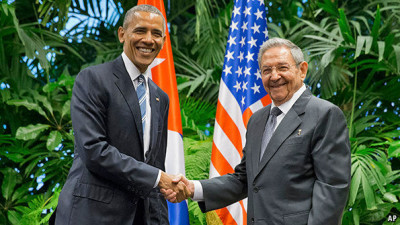
HE MAKES quite a warm-up act. The Rolling Stones will play a free concert in Havana on March 25th in front of an expected audience of 400,000. Five days earlier Barack Obama arrived for a short state visit. Whatever he says, whatever he does, this is a momentous trip—the first by a sitting American president since 1928, when Calvin Coolidge sailed from Prohibition-era America for the Pan-American Conference in Havana. Mr Obama can expect a warm welcome in Cuba. According to a poll last year he is more popular than either Raúl Castro, the president, or Fidel, his brother and the father of the Cuban revolution. Many Cubans have spoken of their enthusiasm for the arrival of a mixed-race president in their country, where non-white citizens are in the majority.
The visit pours more balm on a Cuban-American relationship whose troubles stretch back to the start of the 20th century. The island was put under American military occupation at the end of the Spanish-American war, in 1898, and became independent four years later. But it had to grant the Americans the right to intervene militarily whenever they saw fit. It was a right they used to secure possession of a naval base at Guantánamo Bay at the south-eastern tip of the island. American investment in Cuba, particularly in agriculture, grew over the next decades and tourism flourished—until the takeover by Fidel Castro and his communist forces in 1959 changed the relationship dramatically. That same year Fulgencio Batista, the last pre-Castro leader, fled the country. With America’s possessions on the island being nationalised, it broke off diplomatic ties in 1961 and imposed a full trade, economic and financial embargo the following year. The countries settled into a long spell of mutual distrust, and as recently as 1996 America imposed a new piece of legislation, the Helms-Burton Act, to penalise companies investing in Cuba.
In December 2014, however, the situation changed. Mr Obama and Fidel’s relatively reform-minded brother Raúl announced the restoration of diplomatic ties. This process of normalisation has continued with the loosening of some aspects of the trade and travel embargo; the reopening of embassies in Havana and Washington; and Cuba’s removal from America’s list of state sponsors of terrorism. Mr Obama’s visit is an important step in this process. It signals a new beginning to the way the countries relate to each other and has been received in Cuba as an indication that the American government is starting to see the island as an equal rather than a subordinate. The visit delivers a welcome foreign-policy boost to Mr Obama as he nears the end of a term in which his policies have met with unhappiness in places like Syria, Iraq and Libya. By encouraging contact between the governments, businesses and citizens of Cuba and America he ensures that his policy of re-engagement with Cuba should have sufficient momentum to withstand the hostility of a potential successor such as Ted Cruz. Mr Cruz, whose father is from Cuba, has spoken out against Mr Obama’s approach. But with public opinion increasingly backing the rapprochement, any ideas about turning back the normalisation might have to be shelved.
Mr Obama subscribes to the idea that engaging with the Castro regime has a greater chance of encouraging political change on the island than isolating it. The development of more commercial ties, albeit at a painstakingly slow pace, and the continuing growth in the number of American visitors, serves to bind the two economies together. “Everything that has happened in the last 100 years of Cuban-American relations has been bad,” says Antonio Zamora, a veteran of the Bay of Pigs, the CIA’s failed invasion of 1961. “It’s time to start changing things.”
Editor’s note: The image for this article was updated on March 21st 2016, after Barack Obama met with Raúl Castro
END

Be the first to comment